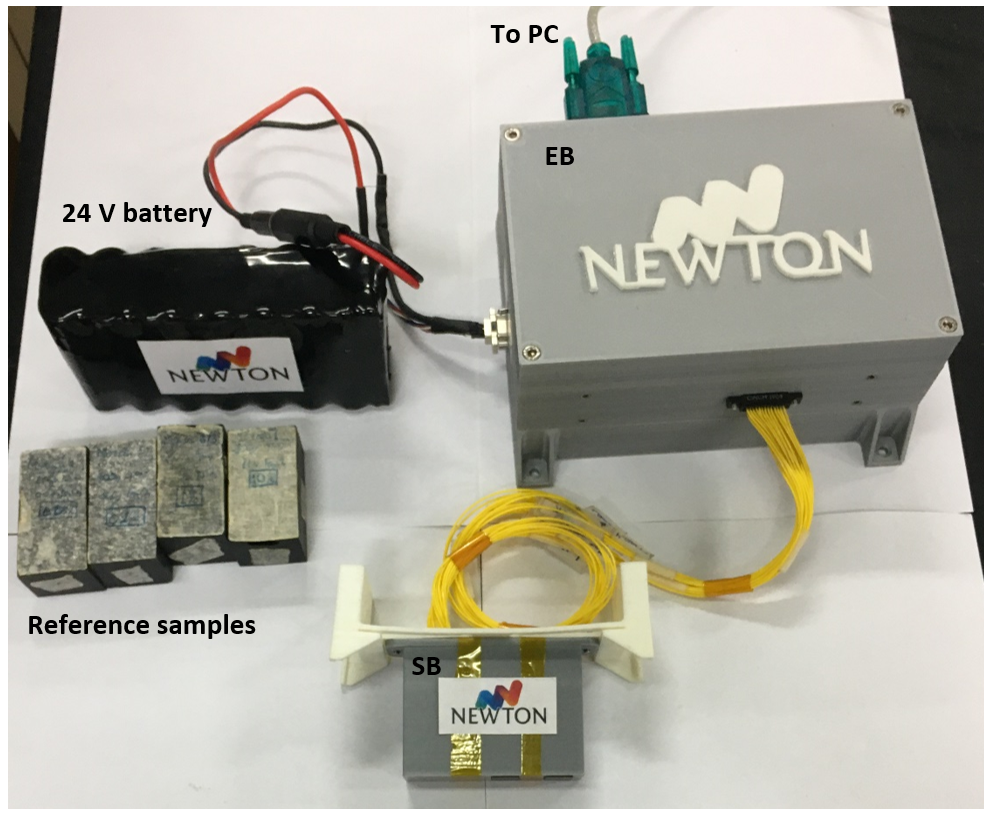- 1Instituto Nacional de Técnica Aeroespacial, Payloads and Space Sciences, Torrejón de Ardoz, Spain (mesaujl@inta.es)
- 2ETSIT- ISOM, Universidad Politécnica de Madrid. Ciudad Universitaria s/n, 28040, Madrid. Spain.
- Introduction
In this work, we present the calibration of the NEWTON magnetic susceptometer for in-situ determination of the magnetic susceptibility of planetary surface rocks and regoliths. The susceptometer is based on inductive methods, and its operation does not require of sample preparation or manipulation. Current prototype has demonstrated capabilities for the determination of the complex magnetic susceptibility, i.e. real and imaginary component of the susceptibility [1, 2]. We propose the NEWTON susceptometer for the determination of the complex magnetic susceptibility, to provide valuable information about the regolith and surface rocks in rocky bodies of the solar system, to be used as a selection criterion of rocks for sample return missions or for the in-situ scientific studies of the magnetic properties during planetary missions.
- Calibration of the susceptometer
Due to the design of the instrument and the nature of the available magnetic susceptibility patterns [3], there are not available susceptibility calibration samples traceable to primary patterns with characteristics compatible with this device. The calibration procedure comprises a comparative methodology, consisting in two steps: the manufacture of magnetic susceptibility patterns, to serve as calibration samples of the real and imaginary parts separately for the NEWTON susceptometer; and the comparison of the results from the prototype with those from reference equipment.
The manufactured samples for the calibration of the real component of the magnetic susceptibility were made of ferrite powder diluted in a non-magnetic epoxy resin. Four samples of different mass content in ferrite powder were made, with the following distribution: a sample with 10% (weight %), a sample with 1%, a sample with 0,1% and a sample with 0,03% in ferrite powder. The homogeneity of the distribution of the ferrite powder within the samples was verified with X-ray images.
The imaginary susceptibility calibration samples were constructed using different techniques and comparing the results with other reference equipment. The sample used for calibration is made of 2.5mm diameter steel spheres (rolling bearing balls) distributed in a cubic lattice in a resin matrix providing both isotropic real and imaginary magnetic susceptibility values.
- Environmental testing
The most critical parts of the instrument have been submitted to qualification tests: vibration, thermal-vacuum and outgassing tests, applying the same requirements and test levels of those for the landing Mars mission, Exomars 2022, to demonstrate the capability of the instrument to withstand the interplanetary missions and space conditions.
- Application of the NEWTON susceptometer
The characterization of the complex magnetic susceptibility of rocks is an unexplored tool to constrain the composition, structure and geological history of rocks in surface planetary exploration [4]. The instrument is designed to measure a dynamic range of the real susceptibility from χ’ = 10-4 S.I. to χ’ = 101 S.I. for the real susceptibility, representative values for the rocks of the Earth, Moon and Mars [5, 6, 7]. The imaginary susceptibility measurement procedure has a resolution in the order of χ” = 10-6.
The sensor is suitable to be placed on board rovers, or to be used as a portable device during field campaigns and by astronauts in manned space missions. This sensor provides a great advantage compared to available commercial susceptometers, given that it does not require sample preparation, but only a minimum sample size (~50 x 20 x 20 mm). The current state of the susceptometer prototype consist of a portable device divided in two boxes: the Sensor Box (SB), containing the sensor core; and the Electronics Box (EV) containing the support electronics for the operation of the instrument (Figure 1).
The application of susceptibility measurements during space missions have a potential impact in the surface regolith and rocks characterization. The analysis of the samples from the Apollo missions [4], the characteristics of the Martian magnetic field [5], works in stony meteorites [6], Earth impact areas [7] and Earth analogues [8] highlight the enhancement of the scientific research that in situ magnetic field and magnetic susceptibility measurements provide to the Lunar and Martian exploration.

Figure 1. Image of the setup of the NEWTON instrument for in situ measurements during field campaigns, including reference samples for calibration.
Acknowledgement
This work has been funded by the Spanish Programme for Research, Development and Innovation under the grants of references ESP2017-88930-R and PID2020-119208RB-I00: MagAres and MINOTAUR, respectively, as well as the European Union Project NEWTON, of grant agreement 730041.
References
[1] J.L. Mesa et al. Feb. 2022. Submitted to IEEE Trans Instrum Meas.
[2] M. Díaz Michelena et al. 2017, Sensor Actuat A-Phys, vol. 263, pp. 471-479
[3] https://www.nist.gov/mml/materials-science-and-engineering-division/magnetic-moment-and-susceptibility-standard-reference. NIST. Retrieved May 4, 2022.
[4] M.S. Bentley et al. 2009, Planet Space Sci, vol. 57 (12), pp. 1491-1499.
[5] P. Rochette et al. 2006, Astrobiology, vol 6(3), pp. 423-36.
[6] P. Rochette 2010, Earth Planet. Sci. Lett., vol. 292, pp. 383–391.
[7] A. Collareta 2016, Meteorit Planet Sci, vol. 51 (2), pp. 351–371
[8] J. Pati, etl al 2016, Curr Sci India, vol. 111 (3), pp. 535-542.
How to cite: Mesa Uña, J. L., Díaz Michelena, M., and Aroca Hernández-Ros, C.: Calibration of NEWTON Susceptometer for fast and in-situ determination of the complex magnetic susceptibility., Europlanet Science Congress 2022, Granada, Spain, 18–23 Sep 2022, EPSC2022-864, https://doi.org/10.5194/epsc2022-864, 2022.

